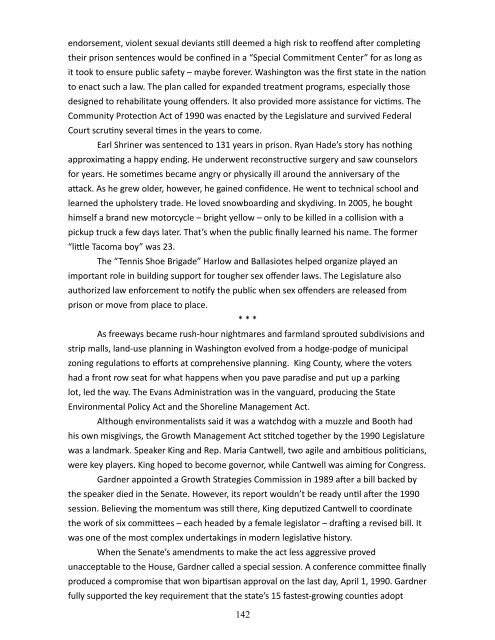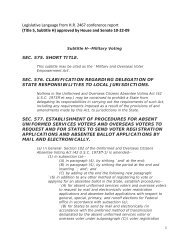booth gardner - Washington Secretary of State
booth gardner - Washington Secretary of State
booth gardner - Washington Secretary of State
You also want an ePaper? Increase the reach of your titles
YUMPU automatically turns print PDFs into web optimized ePapers that Google loves.
endorsement, violent sexual deviants still deemed a high risk to re<strong>of</strong>fend after completing<br />
their prison sentences would be confined in a “Special Commitment Center” for as long as<br />
it took to ensure public safety – maybe forever. <strong>Washington</strong> was the first state in the nation<br />
to enact such a law. The plan called for expanded treatment programs, especially those<br />
designed to rehabilitate young <strong>of</strong>fenders. It also provided more assistance for victims. The<br />
Community Protection Act <strong>of</strong> 1990 was enacted by the Legislature and survived Federal<br />
Court scrutiny several times in the years to come.<br />
Earl Shriner was sentenced to 131 years in prison. Ryan Hade’s story has nothing<br />
approximating a happy ending. He underwent reconstructive surgery and saw counselors<br />
for years. He sometimes became angry or physically ill around the anniversary <strong>of</strong> the<br />
attack. As he grew older, however, he gained confidence. He went to technical school and<br />
learned the upholstery trade. He loved snowboarding and skydiving. In 2005, he bought<br />
himself a brand new motorcycle – bright yellow – only to be killed in a collision with a<br />
pickup truck a few days later. That’s when the public finally learned his name. The former<br />
“little Tacoma boy” was 23.<br />
The “Tennis Shoe Brigade” Harlow and Ballasiotes helped organize played an<br />
important role in building support for tougher sex <strong>of</strong>fender laws. The Legislature also<br />
authorized law enforcement to notify the public when sex <strong>of</strong>fenders are released from<br />
prison or move from place to place.<br />
* * *<br />
As freeways became rush-hour nightmares and farmland sprouted subdivisions and<br />
strip malls, land-use planning in <strong>Washington</strong> evolved from a hodge-podge <strong>of</strong> municipal<br />
zoning regulations to efforts at comprehensive planning. King County, where the voters<br />
had a front row seat for what happens when you pave paradise and put up a parking<br />
lot, led the way. The Evans Administration was in the vanguard, producing the <strong>State</strong><br />
Environmental Policy Act and the Shoreline Management Act.<br />
Although environmentalists said it was a watchdog with a muzzle and Booth had<br />
his own misgivings, the Growth Management Act stitched together by the 1990 Legislature<br />
was a landmark. Speaker King and Rep. Maria Cantwell, two agile and ambitious politicians,<br />
were key players. King hoped to become governor, while Cantwell was aiming for Congress.<br />
Gardner appointed a Growth Strategies Commission in 1989 after a bill backed by<br />
the speaker died in the Senate. However, its report wouldn’t be ready until after the 1990<br />
session. Believing the momentum was still there, King deputized Cantwell to coordinate<br />
the work <strong>of</strong> six committees – each headed by a female legislator – drafting a revised bill. It<br />
was one <strong>of</strong> the most complex undertakings in modern legislative history.<br />
When the Senate’s amendments to make the act less aggressive proved<br />
unacceptable to the House, Gardner called a special session. A conference committee finally<br />
produced a compromise that won bipartisan approval on the last day, April 1, 1990. Gardner<br />
fully supported the key requirement that the state’s 15 fastest-growing counties adopt<br />
142

















